Fletcher Building Bundle
How Does Fletcher Building Dominate the Construction Market?
Fletcher Building, a cornerstone of the Australasian construction landscape since 1909, has constantly adapted its sales and marketing strategies to maintain its leading position. Imagine the impact of a single, well-executed campaign for their eco-friendly building solutions on both their brand and the market. This article explores how Fletcher Building, from its humble beginnings, has evolved its approach to meet the demands of a rapidly changing industry.
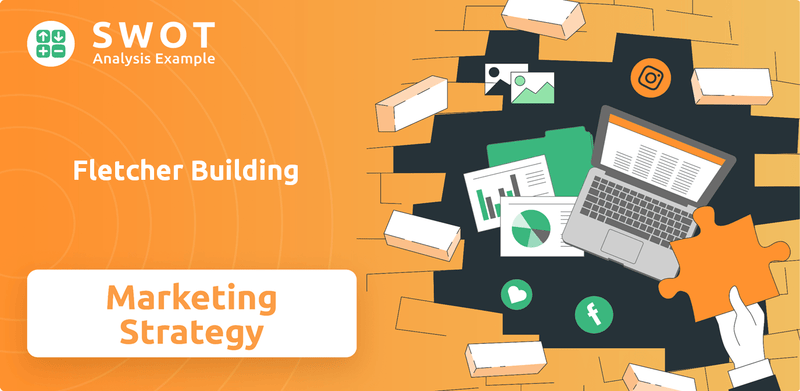
From manufacturing raw materials to undertaking massive projects, the Fletcher Building SWOT Analysis reveals a company navigating a complex market. This analysis will dissect Fletcher Building's sales and marketing plan, examining its digital marketing strategy, brand positioning, and customer relationship management to uncover the secrets behind its success. We'll also explore how Fletcher Building addresses sales and marketing challenges and maintains its competitive advantage through strategic market analysis and innovative campaigns, providing insights into its sales performance review and market share analysis.
How Does Fletcher Building Reach Its Customers?
The sales channels employed by the company, are designed to reach a diverse customer base across New Zealand and Australia. The company's approach blends traditional and modern methods to maximize market penetration and customer engagement. This strategy includes a mix of physical retail locations, direct sales teams, and wholesale distribution networks, complemented by an increasing emphasis on digital platforms.
A key component of the company's sales strategy is its extensive network of physical retail locations, particularly through its brand, Placemakers, in New Zealand. These stores serve as a critical touchpoint for trade professionals and DIY customers, offering a wide range of building materials and expert advice. Direct sales teams also play a crucial role, focusing on securing large-scale commercial and residential construction projects by building relationships with key stakeholders.
Wholesale distributors and partner retailers further extend the company's reach, especially for its manufactured building products, ensuring efficient distribution across various regions. The company's sales and marketing efforts have seen a significant shift towards digital adoption and omnichannel integration to enhance customer convenience and streamline the purchasing process. The company continues to adapt its sales channels to meet evolving market demands.
The company's physical retail presence, particularly through Placemakers, is a cornerstone of its sales strategy. These stores provide direct access to customers, offering building materials and expert advice. This retail network is crucial for serving both trade professionals and DIY customers, ensuring a strong market presence.
Direct sales teams are essential for securing large-scale projects. They focus on building relationships with developers, architects, and government bodies. This approach allows the company to engage directly with key decision-makers and secure significant contracts.
Wholesale distributors and partner retailers play a vital role in expanding market reach, particularly for manufactured building products. This channel strategy ensures efficient distribution across various regions. Partnerships help broaden the company's market penetration.
The company is increasingly investing in digital platforms, including e-commerce, to enhance customer convenience. This digital push aims to streamline the purchasing process. The integration of online and offline channels is a key focus for the future.
The company's sales strategy is multifaceted, combining physical retail, direct sales, and wholesale distribution. The company’s approach ensures broad market coverage and customer engagement. The company's focus on digital adoption and omnichannel integration reflects its commitment to adapting to evolving market dynamics. For further insights into the company's overall strategy, refer to the Growth Strategy of Fletcher Building.
The company's sales strategy focuses on a multi-channel approach to reach its diverse customer base. This includes retail stores, direct sales teams, and wholesale partnerships, all supported by digital initiatives. The company's approach aims to maximize market penetration and customer satisfaction.
- Retail Locations: Placemakers stores provide direct customer access.
- Direct Sales: Teams focus on securing large-scale projects.
- Wholesale Distribution: Partners expand market reach.
- Digital Integration: E-commerce enhances customer convenience.
Fletcher Building SWOT Analysis
- Complete SWOT Breakdown
- Fully Customizable
- Editable in Excel & Word
- Professional Formatting
- Investor-Ready Format
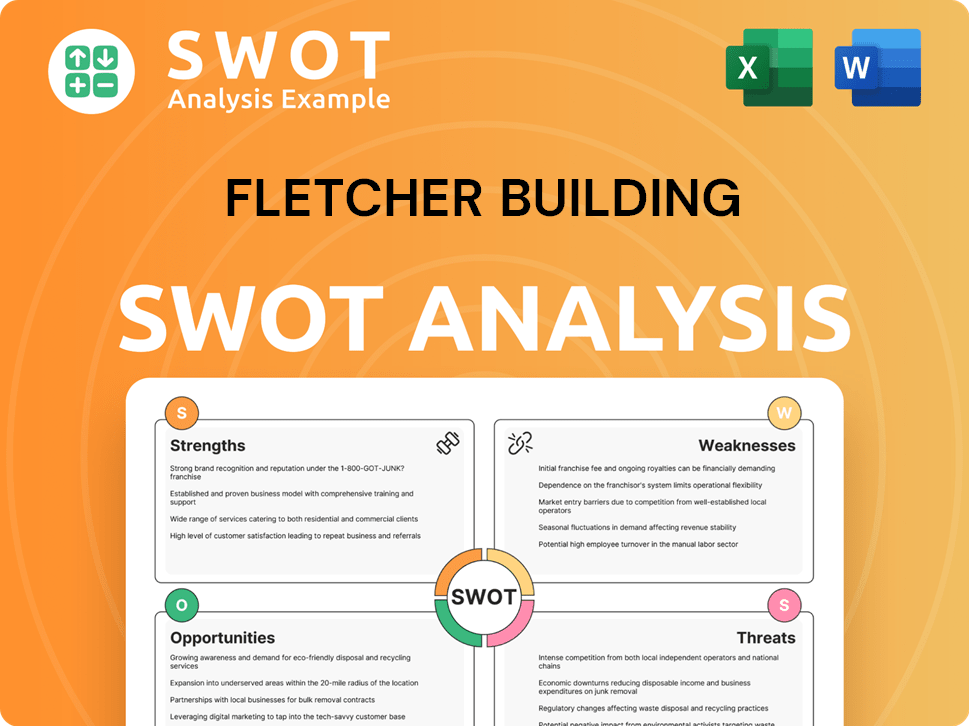
What Marketing Tactics Does Fletcher Building Use?
The marketing tactics employed by the company are multifaceted, designed to boost brand recognition, generate leads, and ultimately drive sales across its various business units. The company's approach is increasingly data-driven, utilizing analytics to understand customer behavior and optimize marketing spend. This strategy reflects the evolving media consumption habits of its customers, with a greater emphasis on digital engagement while maintaining a strong presence in traditional channels.
The company's marketing strategy encompasses a blend of digital and traditional methods. Digital strategies include content marketing, SEO, and paid advertising. Traditional methods may include industry-specific print publications and trade shows. The company adapts its tactics to align with customer preferences and market trends.
The company's marketing efforts are focused on reaching a diverse audience, from homeowners to industry professionals. By leveraging a mix of digital and traditional channels, the company aims to maintain a strong market presence and foster customer engagement. For a deeper understanding of the company's financial performance and strategic direction, consider exploring resources like Owners & Shareholders of Fletcher Building.
Digital marketing forms a core part of the company's strategy, with a focus on content marketing to provide valuable resources. Search Engine Optimization (SEO) is used to ensure visibility in online searches. Paid advertising, including SEM and display ads, targets specific customer segments.
Content marketing provides valuable resources and insights to the target audience. This includes building guides for homeowners and technical specifications for professionals. This helps to establish the company as a trusted source of information.
SEO is crucial for online visibility, ensuring the company appears in searches for building materials and construction services. Paid advertising, including search engine marketing (SEM), targets specific customer segments. These efforts drive traffic and generate leads.
Traditional media, such as industry-specific print publications, trade shows, and events, remains relevant. These channels connect with professionals and showcase innovations. This approach helps maintain a strong presence in the industry.
The company utilizes analytics to understand customer behavior, segment audiences, and personalize communications. Data-driven insights help optimize marketing spend and improve campaign effectiveness. This ensures efficient resource allocation.
Innovations might include interactive online tools for product selection or project planning. These tools enhance the customer experience and provide valuable resources. This approach focuses on customer satisfaction.
The company's marketing strategy is a blend of digital and traditional channels, emphasizing data-driven insights to optimize campaigns and enhance customer engagement. This approach is designed to reach a wide audience and drive sales.
- Content Marketing: Providing valuable resources like building guides.
- SEO: Ensuring visibility in online searches for building materials.
- Paid Advertising: Targeting specific customer segments with SEM and display ads.
- Traditional Media: Utilizing industry-specific print publications and trade shows.
- Data Analytics: Understanding customer behavior to personalize communications.
- Customer Experience: Developing interactive online tools for product selection.
Fletcher Building PESTLE Analysis
- Covers All 6 PESTLE Categories
- No Research Needed – Save Hours of Work
- Built by Experts, Trusted by Consultants
- Instant Download, Ready to Use
- 100% Editable, Fully Customizable
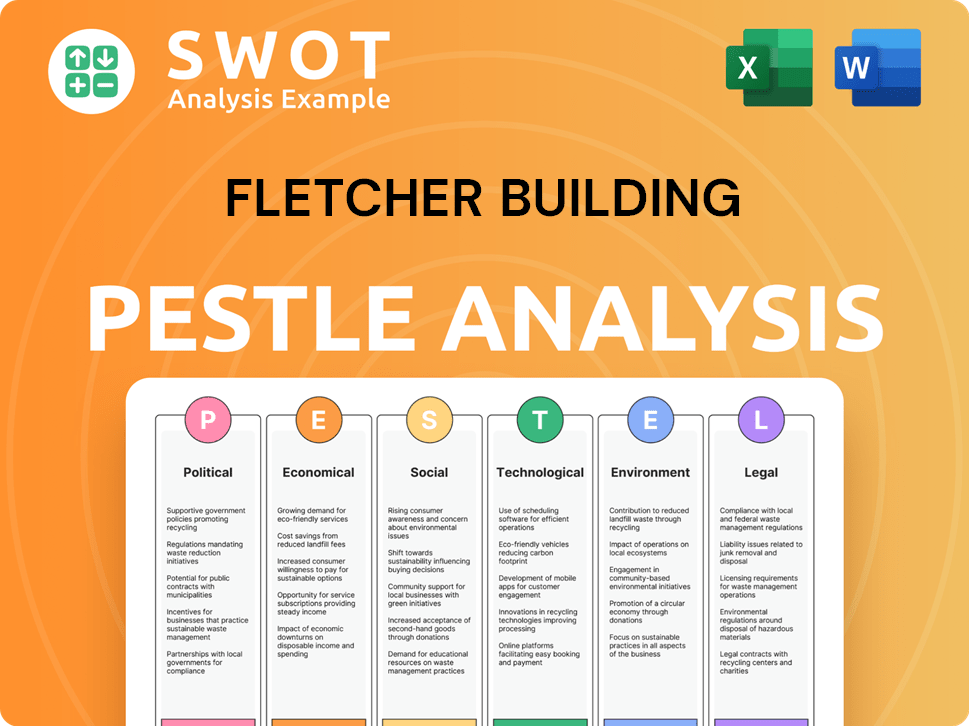
How Is Fletcher Building Positioned in the Market?
Fletcher Building positions itself as a leading provider of construction solutions and building materials, primarily in Australasia. The company's brand strategy centers around reliability, quality, and a commitment to sustainable practices, aiming to build trust with both trade professionals and general consumers. Their core message often highlights their role in constructing essential infrastructure and living spaces, using imagery that conveys strength, innovation, and environmental responsibility.
The brand's tone of voice is professional and authoritative, yet accessible, ensuring a unified brand experience across all touchpoints. This unified approach is crucial for maintaining a consistent brand image, whether customers interact with a store, a sales representative, or the company's website. Fletcher Building's brand positioning strategy is designed to resonate with a broad audience, from trade professionals to residential customers.
Fletcher Building's customer experience promises comprehensive support, from product selection to project completion, underpinned by expertise and a broad product range. They adapt their product offerings and marketing messages to maintain their competitive edge, responding to shifts in consumer sentiment, such as the increased demand for energy-efficient or modular construction solutions. This adaptability is key to their long-term success in a dynamic market.
Fletcher Building's target audience includes trade professionals and residential customers. They cater to trade professionals with an extensive product range, reliability, and a well-established distribution network. For residential customers, the focus is on the quality and durability of their materials and the trust associated with a long-standing company.
Key selling propositions include an extensive product range, reliability, and a strong distribution network for trade professionals. For residential customers, the focus is on quality and durability. Sustainability is increasingly emphasized as a unique selling proposition, aligning with growing market demand for environmentally friendly building solutions.
Fletcher Building likely utilizes a mix of marketing channels, including their retail stores (e.g., Placemakers), sales representatives, and a strong online presence. They likely employ digital marketing strategies to reach a wider audience and provide comprehensive customer support.
Their competitive advantages include market leadership, a wide product range, a strong distribution network, and a focus on sustainability. The company's long-standing reputation and consistent brand experience across various touchpoints also contribute to its competitive edge.
Fletcher Building is increasingly emphasizing sustainability, aligning with market demand for environmentally friendly building solutions. This focus is a key element of their brand positioning, appealing to consumers and stakeholders who prioritize eco-friendly practices.
- Emphasis on sustainable materials and practices.
- Adaptation to consumer demand for green building solutions.
- Integration of sustainability into marketing messages.
- Focus on reducing environmental impact.
Fletcher Building Business Model Canvas
- Complete 9-Block Business Model Canvas
- Effortlessly Communicate Your Business Strategy
- Investor-Ready BMC Format
- 100% Editable and Customizable
- Clear and Structured Layout
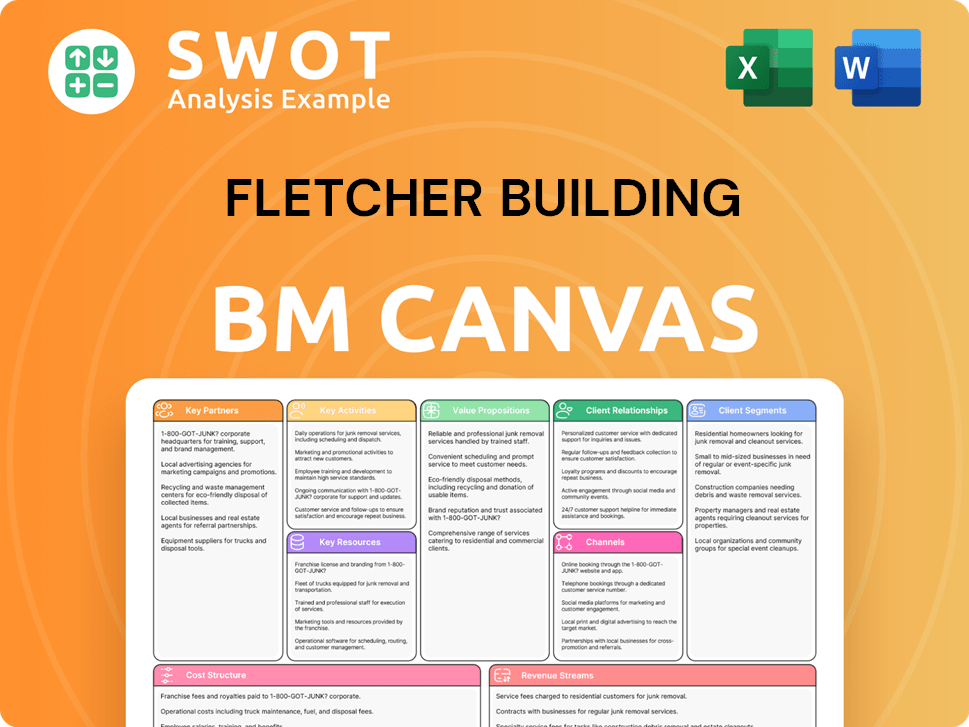
What Are Fletcher Building’s Most Notable Campaigns?
Historically, the sales and marketing efforts of the company have likely centered on showcasing its wide array of products and its involvement in significant infrastructure projects. This approach has helped reinforce its image as a key player in the construction industry. More recently, there's been a shift towards emphasizing sustainability and innovation in their campaigns. Understanding the nuances of the Competitors Landscape of Fletcher Building is crucial for evaluating its marketing strategies.
Focusing on sustainability, for instance, could involve promoting low-carbon concrete or recycled materials. The goal is to enhance the brand's perception as an environmentally conscious leader and encourage the adoption of its green products. This could involve showcasing real-world projects using these sustainable materials, highlighting their benefits and environmental impact. This approach is likely to be a key element in their sales and marketing plan.
The main channels for such a campaign would likely include industry trade publications, digital platforms targeting architects and developers, and potentially public relations efforts to secure media coverage in business and sustainability-focused outlets. The success of such campaigns would be measured by increased inquiries for sustainable products and positive shifts in brand perception surveys. The company's marketing channel strategy is crucial for reaching its target market analysis.
This campaign highlights the company's commitment to sustainable building practices. It showcases low-carbon concrete and recycled materials. The goal is to position the company as an environmentally conscious leader in the industry.
Focusing on major national infrastructure projects where the company's products are utilized. This campaign aims to demonstrate the company's capabilities and its contribution to national development. These projects are a key part of the company's sales process optimization.
This campaign promotes the company's latest construction materials and technologies. It emphasizes the benefits of these innovations, such as improved durability, cost-effectiveness, and sustainability. The company's digital marketing strategy supports this.
This involves campaigns that focus on understanding customer needs and providing tailored solutions. It includes initiatives like customer feedback programs and personalized marketing. This strategy is a key part of the company's customer relationship management.
Measuring the effectiveness of marketing campaigns is crucial. Key metrics include increased inquiries, positive shifts in brand perception, and sales growth. The company's sales team structure is designed to support this.
- Increased Sales: A primary goal is to boost sales of sustainable products and innovative materials.
- Brand Perception: Monitoring shifts in brand perception through surveys and media coverage.
- Customer Engagement: Tracking customer interactions and feedback to measure campaign effectiveness.
- Market Share: Analyzing changes in market share to understand the impact of marketing efforts.
Fletcher Building Porter's Five Forces Analysis
- Covers All 5 Competitive Forces in Detail
- Structured for Consultants, Students, and Founders
- 100% Editable in Microsoft Word & Excel
- Instant Digital Download – Use Immediately
- Compatible with Mac & PC – Fully Unlocked
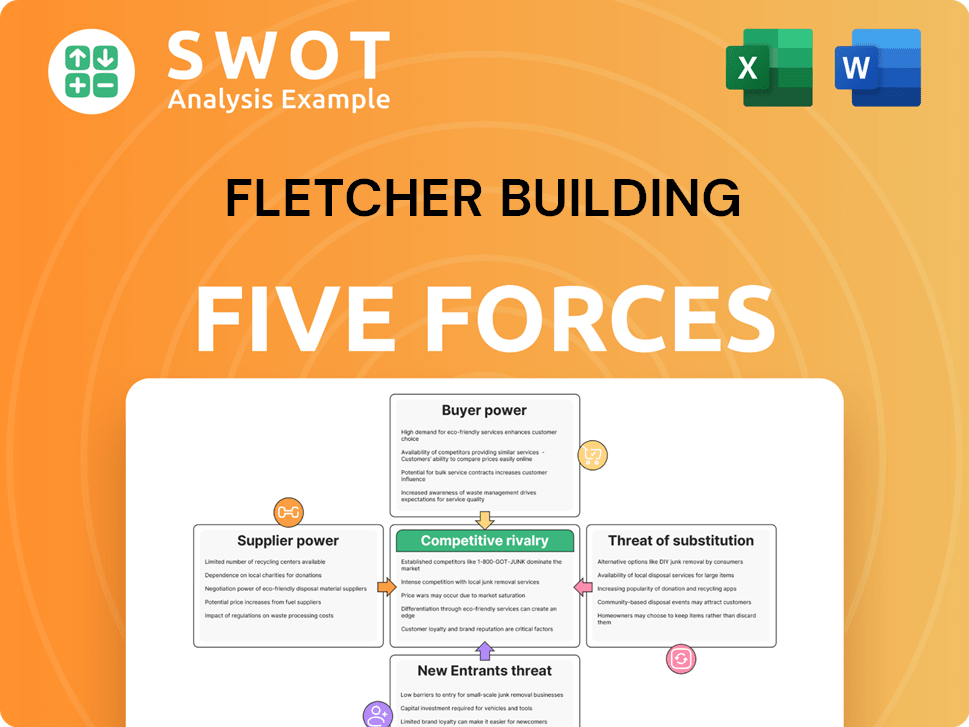
Related Blogs
- What are Mission Vision & Core Values of Fletcher Building Company?
- What is Competitive Landscape of Fletcher Building Company?
- What is Growth Strategy and Future Prospects of Fletcher Building Company?
- How Does Fletcher Building Company Work?
- What is Brief History of Fletcher Building Company?
- Who Owns Fletcher Building Company?
- What is Customer Demographics and Target Market of Fletcher Building Company?
Disclaimer
All information, articles, and product details provided on this website are for general informational and educational purposes only. We do not claim any ownership over, nor do we intend to infringe upon, any trademarks, copyrights, logos, brand names, or other intellectual property mentioned or depicted on this site. Such intellectual property remains the property of its respective owners, and any references here are made solely for identification or informational purposes, without implying any affiliation, endorsement, or partnership.
We make no representations or warranties, express or implied, regarding the accuracy, completeness, or suitability of any content or products presented. Nothing on this website should be construed as legal, tax, investment, financial, medical, or other professional advice. In addition, no part of this site—including articles or product references—constitutes a solicitation, recommendation, endorsement, advertisement, or offer to buy or sell any securities, franchises, or other financial instruments, particularly in jurisdictions where such activity would be unlawful.
All content is of a general nature and may not address the specific circumstances of any individual or entity. It is not a substitute for professional advice or services. Any actions you take based on the information provided here are strictly at your own risk. You accept full responsibility for any decisions or outcomes arising from your use of this website and agree to release us from any liability in connection with your use of, or reliance upon, the content or products found herein.